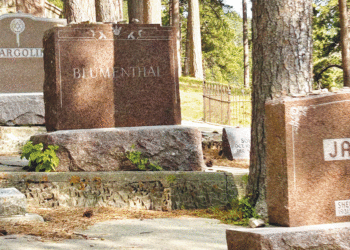Heavy Table, the local foodie blog, recently publicized the “Haute Cuisine Tu B’Shevat Dinner,” which takes place Feb. 3 at Beth El Synagogue in St. Louis Park. The article notes that some considerable “culinary firepower” — Chef Daniel del Prado, of Burch Steak and Pizza Bar; Chef Tony Pester, of Pescara in Rochester; Chef Thomas Boemer, of Corner Table; and Chef Dawn Drouillard, of Fabulous Catering — will be preparing the eight-course meal.
The dinner will highlight the Seven Species from the Land of Israel: wheat, barley, grape (wine), fig, pomegranate, olive (oil) and honey. Each chef will prepare two dishes; honey “may refer to date honey or bee honey, so that species will receive two interpretations,” according to Heavy Table.
Chef del Prado told Heavy Table that cooking haute cuisine kosher is a serious challenge, as it involves attention to kashrut (Jewish dietary laws), in the meal prep and ingredient sourcing. “It’s very hard to do, actually,” he says.
Heavy Table adds: “His dishes include the barley and wheat courses; for the former, he’ll make a barley butternut squash soup with blue borage flowers and seaweed, and for the latter, a beef tartare with lavash crackers and pickled wheat kernels with mustard seeds.”
By the way, reservations for the shul’s Tu B’Shevat dinner are $125 per person.
Apart from the mouth-watering aspects of Tu B’Shevat, the 15th day of Shevat has become known at the “Jewish Arbor Day” — or a Jewish Earth Day. Every day should be Earth Day, and a time to reflect on how we can sustain our imperiled planet, which sustains each and every one of us. The natural world is under threat from industrial development — oil and gas extraction and pipelines, chemical manufacturing, hard rock mining, the nuclear fuel cycle, etc. As global climate change continues apace, the human race seems set on a course of self-extinction.
Many years ago, I met a Muscogee (Creek) spiritual leader, Phillip Deere. He was a charismatic figure, with his distinctive wide-brimmed black hat, earrings, choker and serape. I had the good fortune to meet him several times: at the White Earth reservation up north, in northern Saskatchewan, and at his ranch near Okemah, Okla. (the birthplace of Woody Guthrie). Deere, who died in 1985, primarily aimed his teachings at young Indians who were troubled and adrift in American society. He counseled them to return to their ancestral ways. And many non-Indians were fascinated by Deere, who was a renowned orator on themes relating to ecology.
More than 30 years later, I recall him talking about our precious water, and how his ancestors could travel across this land, and put their mouth in any stream and drink their fill.
Most of us acknowledge that American Indians got a raw deal with the European settlement of North America. Apart from Wounded Knee and Sand Creek, and other massacres by the U.S. cavalry, the domestic Indian nations were swindled in treaties that took their land base; the buffalo, which provided food, clothing and shelter, were slaughtered on the northern Great Plains; and, among other depredations, traditional Indian spiritual ceremonies were outlawed by the federal government.
In my reporting from Indian Country, I’ve seen disputes over land rights lead to violations of human rights, when push comes to shove. Phillip Deere recounted this sad history and warned, “If the Indian can be slapped around and shoved around all these years, who is going to be the next Indian?… If you are not careful, you are going to be the next Indian.”
Over recent years, my writing for The Circle, the American Indian monthly newspaper in Minneapolis, has focused on proposed copper-nickel mining in northeastern Minnesota, Keystone XL and other oil pipelines, and the recent killing of wolves for sport in the western Great Lakes states.
I have noted that in some of these areas, such as the copper-nickel mining controversy, there’s tension between proponents of environmental preservation and those calling for economic development and jobs. On this point, a story in the Star Tribune this week focused on the Minnesota Legislature, where pro-business Republicans, who now control the House, are joining Iron Range DFLers, who “often have taken a similarly skeptical view of environmental rules as they’ve watched good jobs vanish over the years.”
This “new political dynamic” will “play out [during the 2015] session as agribusiness, mining and other industries and their legislative allies try to press their new advantage while environmental activists play defense,” according to the Star Tribune, which also pointed out that Gov. Mark Dayton has proposed “tougher clean water rules.”
The thing is, everybody needs clean air and water. Again, in the case of copper-nickel mining, the history of this industry across the western U.S. has been a catalogue of disasters. Mining interests have polluted streams and groundwater, then gone bust, leaving the taxpayers to clean up their messes.
My columns for The Circle, and articles for other American Indian news outlets, have examined these environmental issues from a tribal perspective. A 2013 report, “Honoring the River: How Hardrock Mining Impacts Tribal Communities,” issued by the National Wildlife Federation, pointed out: “American Indian tribes across the United States have been severely impacted by the tailings and other toxic waste dumped into America’s waterways by the metals mining industry. Tribes own and manage over 95 million acres of land, much of it containing large intact habitats, abundant wildlife, clean water and air, and unique cultural and historic resources.”
The report stated that loopholes in the federal Clean Water Act “have allowed mines to treat rivers, lakes and wetlands as waste dumps for toxic, acid-producing tailings. According to the report, the metals mining industry has already contaminated an estimated 40 percent of the headwaters in western watersheds.”
Invariably, after a tailings pond spills or a pipeline bursts, you can go back to the offending corporation’s Web site and read about their diligent approach to environmental safety.
I’m not a Jewish theologian, but the Jewish Sources discuss bal tashchit (do not destroy), the prohibition against excessive waste. Apparently, this comes from the mitzva prohibiting cutting down fruit trees in wartime: “When in your war against a city you have to besiege it a long time in order to capture it, you must not destroy its trees, wielding the ax against them. You may eat of them, but you must not cut them down” (Deuteronomy 20:19). Later Talmudic discussions broadened this principle to the wasting of lamp oil, chopping up furniture for firewood and killing of animals. Any destruction has to have an adequate justification, according to the Sources.
This mitzva and its interpretations should guide our thinking about current environmental issues. We need a functioning economy; but development cannot be allowed to foul our air and water. As the saying goes, there’s no Planet B.
If we allow unnecessary destruction of the natural world, our survival system, a dismal fate awaits humankind. As Phillip Deere warned, “you are going to be the next Indian.”
— Mordecai Specktor / editor@ajwnews.com
(American Jewish World, 1.30.15)



















